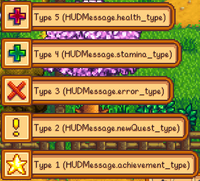「模组:常用方法」修訂間的差異
| 行 241: | 行 241: | ||
Game1.activeClickableMenu = new DialogueBox(message); | Game1.activeClickableMenu = new DialogueBox(message); | ||
</syntaxhighlight> | </syntaxhighlight> | ||
| + | |||
| + | ==邮件 (Mail)== | ||
| + | // 未翻译 | ||
| + | ===概述=== | ||
| + | // 未翻译 | ||
| + | ===注入静态内容 (Inject static content)=== | ||
| + | // 未翻译 | ||
| + | ===客户端调用静态内容 (Send a letter with static content)=== | ||
| + | // 未翻译 | ||
| + | ===注入动态内容 (Inject dynamic content)=== | ||
| + | // 未翻译 | ||
| + | ===客户端调用动态内容 (Send a letter with dynamic content)=== | ||
| + | // 未翻译 | ||
| + | |||
| + | ==其他 (Other)== | ||
| + | ===简单动画(animation) 的添加=== | ||
| + | <syntaxhighlight lang='c#'> | ||
| + | location.temporarySprites.Add(new TemporaryAnimatedSprite(...)); | ||
| + | </syntaxhighlight> | ||
| + | 详见<tt>TemporaryAnimatedSprite</tt>类。 | ||
| + | |||
| + | ===播放一段声音=== | ||
| + | <syntaxhighlight lang='c#'> | ||
| + | location.playSound("SOUND"); // "SOUND"为声音的名字 | ||
| + | </syntaxhighlight> | ||
| + | 详见[https://docs.google.com/spreadsheets/d/1CpDrw23peQiq-C7F2FjYOMePaYe0Rc9BwQsj3h6sjyo/edit#gid=239695361 声音名字一览]。 | ||
[[en:Modding:Common tasks]] | [[en:Modding:Common tasks]] | ||
[[ru:Модификации:Основные возможности]] | [[ru:Модификации:Основные возможности]] | ||
於 2021年6月11日 (五) 01:06 的修訂
← 目錄
| 頁面仍需完善
該頁面不完善且缺少信息。您可以通過擴充內容來幫助我們。 |

|
不完整的翻譯 本文或部分尚未完全翻譯成中文。
歡迎您通過編輯幫助其建設。 |
此頁面展示了製作SMAPI模組時常見的任務。在閱讀時,請結合參考模組製作入門和遊戲基本架構。
基礎技巧
追蹤一個值的變化
在寫模組時,你可能常常需要了解一個值的變化(什麼時候變,變化前後的值分別是多少,等等)。如果該值沒有包括在SMAPI內置的事件 (event)中,那麼你可以為該值創建一個私有變量,然後在SMAPI的update tick事件中刷新此變量,以達到追蹤值變化的目的。
示例見:[模組:製作指南/APIs/Events#變化監控]
物品 (Items)
物品 代表那些能夠放在背包里的東西,比如說工具、農作物等等。
創建一個物品 (Object) 的實例
Object中所有的構造函數:
public Object(Vector2 tileLocation, int parentSheetIndex, int initialStack);
public Object(Vector2 tileLocation, int parentSheetIndex, bool isRecipe = false);
public Object(int parentSheetIndex, int initialStack, bool isRecipe = false, int price = -1, int quality = 0);
public Object(Vector2 tileLocation, int parentSheetIndex, string Givenname, bool canBeSetDown, bool canBeGrabbed, bool isHoedirt, bool isSpawnedObject);
參數parentSheetIndex表示該物品的ID(儲存在 ObjectInformation.xnb 文件中)。
在地上生成物品
public virtual bool dropObject(Object obj, Vector2 dropLocation, xTile.Dimensions.Rectangle viewport, bool initialPlacement, Farmer who = null);
// 调用:
Game1.getLocationFromName("Farm").dropObject(new StardewValley.Object(itemId, 1, false, -1, 0), new Vector2(x, y) * 64f, Game1.viewport, true, (Farmer)null);
添加物品到背包 (Inventory)
// You can add items found in ObjectInformation using:
Game1.player.addItemByMenuIfNecessary((Item)new StardewValley.Object(int parentSheetIndex, int initialStack, [bool isRecipe = false], [int price = -1], [int quality = 0]));
例2:
// Add a weapon directly into player's inventory
const int WEAP_ID = 19; // Shadow Dagger -- see Data/weapons
Item weapon = new MeleeWeapon(WEAP_ID); // MeleeWeapon is a class in StardewValley.Tools
Game1.player.addItemByMenuIfNecessary(weapon);
// Note: This code WORKS.
從背包移除物品
取決於你背包的具體情況。很少有情況需要你親自來調用,因為相關的方法在Farmer類中已經有了。
在大多數情況下,僅需調用 .removeItemFromInventory(Item) 方法。
地點 (Locations)
見 遊戲基本架構#地點。
獲取所有地點
Game1.locations屬性中雖然儲存著主要的地點,但是不包括建築的室內(constructed building interiors)。以下這個方法提供了主玩家的所有地點。
/// <summary>Get all game locations.</summary>
public static IEnumerable<GameLocation> GetLocations()
{
return Game1.locations
.Concat(
from location in Game1.locations.OfType<BuildableGameLocation>()
from building in location.buildings
where building.indoors.Value != null
select building.indoors.Value
);
}
遍歷:
foreach (GameLocation location in this.GetLocations())
{
// ...
}
注意:在聯機模式中,客機是拿不到上述所有地點的。要解決這一問題,見獲取有效的地點。
編輯地圖
見模組:地圖數據。
玩家 (Player)
自定義精靈 (Custom Sprite)
位置 (Position)
角色(Character) 的位置(Position) 表示他在當前地點(Location) 的坐標。
相對於地圖 (Map)
每個地點(location) 都有一個對應的xTile地圖(map)。如果以像素(pixel) 為單位,地圖左上角坐標代表(0, 0),坐下角則代表(location.Map.DisplayWidth, location.Map.DisplayHeight)。 角色在當前地點的位置有兩種表達方式:
- 以像素(pixel) 為單位的絕對(absoulte) 坐標:
Position.X與Position.Y。 - 以圖塊(tile) 為單位的圖塊(tile) 坐標:
getTileX()與getTileY()。
常量Game1.tileSize規定,遊戲內每個圖塊(tile) 大小為64x64像素。於是有以下單位換算:
// 绝对坐标 → 图块坐标
Math.Floor(Game1.player.Position.X / Game1.tileSize)
Math.Floor(Game1.player.Position.Y / Game1.tileSize)
// 图块坐标 → 绝对坐标
Game1.player.getTileX() * Game1.tileSize
Game1.player.getTileY() * Game1.tileSize
// 地图大小(以图块为单位)
Math.Floor(Game1.player.currentLocation.Map.DisplayWidth / Game1.tileSize)
Math.Floor(Game1.player.currentLocation.Map.DisplayHeight / Game1.tileSize)
相對於視野 (Viewport)
視野、視口、視窗(Viewport) 代表在當前屏幕上的區域。若以像素計算,其寬高應該與遊戲的屏幕解析度相等,分別為Game1.viewport.Width和Game1.viewport.Height。
玩家相對於視野的位置(像素)可表示為:
Game1.player.Position.X - Game1.viewport.X
Game1.player.Position.Y - Game1.viewport.Y
NPC
自定義NPC
想要自定義NPC,你得修改或添加以下文件:
格式: 具體操作:(往)目標文件夾或文件名
- 添加新文件:Characters\Dialogue\<文件名>
- 添加新文件:Characters\schedules\<文件名>
- 添加新文件:Portraits\<文件名>
- 添加新文件:Characters\<文件名>
- 在已有文件中添加新的條目:Data\EngagementDialogue(可結婚NPC)
- 在已有文件中添加新的條目:Data\NPCDispositions
- 在已有文件中添加新的條目:Data\NPCGiftTastes
- 在已有文件中添加新的條目:Characters\Dialogue\rainy
- 在已有文件中添加新的條目:Data\animationDescriptions(在行程(schedule) 中增加自定義的動畫)
以上所有的操作都可以通過IAssetLoaders/IAssetEditors或者Content Patcher做到。
最後,你需要調用NPC的構造器來創建實例。
public NPC(AnimatedSprite sprite, Vector2 position, int facingDir, string name, LocalizedContentManager content = null);
public NPC(AnimatedSprite sprite, Vector2 position, string defaultMap, int facingDir, string name, Dictionary<int, int[]> schedule, Texture2D portrait, bool eventActor);
public NPC(AnimatedSprite sprite, Vector2 position, string defaultMap, int facingDirection, string name, bool datable, Dictionary<int, int[]> schedule, Texture2D portrait);
// 调用:
Game1.getLocationFromName("Town").addCharacter(npc);
用戶界面 (UI)
用戶界面(User-interface、UI) 是指一系列有關界面元素(如按鈕、列表框、下拉框等等)以及它們組合起來呈現的畫面(如菜單、HUD等等)。
//TODO:歡迎補充UI方面的內容。
HUD消息
HUD消息是指你屏幕左下角時常彈出來的消息框。以下是它的構造函數(不包括一部分無關的):
public HUDMessage(string message);
public HUDMessage(string message, int whatType);
public HUDMessage(string type, int number, bool add, Color color, Item messageSubject = null);
public HUDMessage(string message, string leaveMeNull)
public HUDMessage(string message, Color color, float timeLeft, bool fadeIn)
可選的樣式(type):
- 成就
HUDMessage.achievement_type - 新任務
HUDMessage.newQuest_type - 錯誤
HUDMessage.error_type - 體力值
HUDMessage.stamina_type - 生命值
HUDMessage.health_type
顏色(color):
第1、2個構造器並沒有給出表示顏色的參數,此時顏色默認為Color.OrangeRed。
若使用第4個構造器,顏色則與遊戲內文字顏色一樣。
特別:
- public HUDMessage(string type, int number, bool add, Color color, Item messageSubject = null); 支持消息內容擴展。常用於金錢相關。
- public HUDMessage(string message, string leaveMeNull); 左側沒有圖標框。
- public HUDMessage(string message, Color color, float timeLeft, bool fadeIn); 文字漸入效果。
Game1.addHUDMessage(new HUDMessage("MESSAGE", 3));
示例2: 彈出一個純文字的消息框。
Game1.addHUDMessage(new HUDMessage("MESSAGE", "")); // second parameter is the 'leaveMeNull' parameter
菜單指繪製於最頂層的UI,能夠接受用戶輸入。比方說,當你按下ESC或B鍵時呈現的GameMenu就是一個菜單。
菜單的值儲存在Game1.activeClickableMenu,當該欄位不為null時,其值便能呈現出一個菜單了。
每個菜單不盡相同,請閱讀代碼來了解其運作方式。你可能經常需要了解GameMenu的當前欄目 (tab),這是一個示例:
if (Game1.activeClickableMenu is GameMenu menu)
{
// 获取栏目页
IList<IClickableMenu> pages = this.Helper.Reflection.GetField<List<IClickableMenu>>(menu, "pages").GetValue();
// 方法1:比较栏目的ID
if (menu.currentTab == GameMenu.mapTab)
{
...
}
// 方法2:比较菜单类型
switch (pages[menu.currentTab])
{
case MapPage mapPage:
...
break;
}
}
如果你想要自定義菜單,請繼承自IClickableMenu,將對象分配給Game1.activeClickableMenu。 一個菜單基本上重寫了一些方法,如draw、receiveLeftClick 等等。 draw方法繪製屏幕上的元素;receiveLeftClick 方法處理左鍵點擊事件。 你通常可以使用一些遊戲封裝好的類作為菜單元素,如ClickableTextureButton。
這裡提供了一個簡單的例子,這是Birthday Mod的菜單。
對話框 (DialogueBox)
對話框有許多變種,比如有種對話框能夠選擇想要的對話內容。
如果想換行,請輸入"^"。
下面是一種不帶選項的對話框示例:
using StardewValley.Menus; // 引用DialogueBox类的命名空间
string message = "This looks like a typewriter ... ^But it's not ...^It's a computer.^";
Game1.activeClickableMenu = new DialogueBox(message);
郵件 (Mail)
// 未翻譯
概述
// 未翻譯
注入靜態內容 (Inject static content)
// 未翻譯
客戶端調用靜態內容 (Send a letter with static content)
// 未翻譯
注入動態內容 (Inject dynamic content)
// 未翻譯
客戶端調用動態內容 (Send a letter with dynamic content)
// 未翻譯
其他 (Other)
簡單動畫(animation) 的添加
location.temporarySprites.Add(new TemporaryAnimatedSprite(...));
詳見TemporaryAnimatedSprite類。
播放一段聲音
location.playSound("SOUND"); // "SOUND"为声音的名字
詳見聲音名字一覽。

